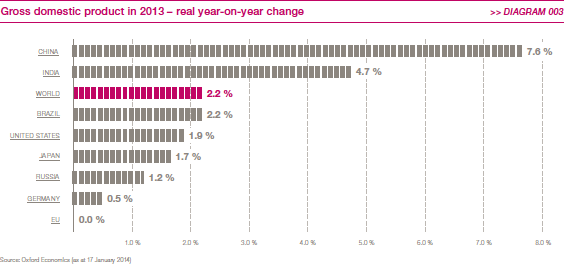Macroeconomic conditions
The global economy grew by 2.2 per cent in 2013. This was slightly less than in the previous year, which was due, above all, to a slower rate of growth in many emerging markets. Although the mood in Europe and the United States brightened considerably in the second half of the year, global economic growth was sluggish.
Economic performance in the European Union stabilised over the course of 2013. Despite contracting significantly in the first quarter, gross domestic product (GDP) over the year as a whole reached the same level as in 2012. Germany and the United Kingdom were the main drivers of the recovery in western Europe during the year. However, negative growth rates in Italy and Spain and increasing problems in France demonstrate that the eurozone has not yet emerged from the crisis. This also held back growth in neighbouring countries. Many eastern European countries, including Russia, achieved lower rates of growth than in 2012.
Among the Asian emerging markets, China registered growth at almost the same level as in the previous year and quickly overcame a short-lived period of economic weakness. Other Asian countries, including Indonesia and Thailand, generated weaker growth than in 2012. Brazil continued along its upward trajectory, although the pace of growth was slower. Despite muted growth, emerging markets remained the economic powerhouses of the global economy with gains of 4.5 per cent. >> Diagram 003
Demand for industrial trucks is largely driven by investment confidence and world trade volumes as well as GDP growth. Like GDP, worldwide spending on capital equipment increased only cautiously as ongoing uncertainty about growth prospects have continued to dampen companies’ willingness to invest, particularly in the eurozone. Global trade in 2013 was once again well behind the medium-term trend.
